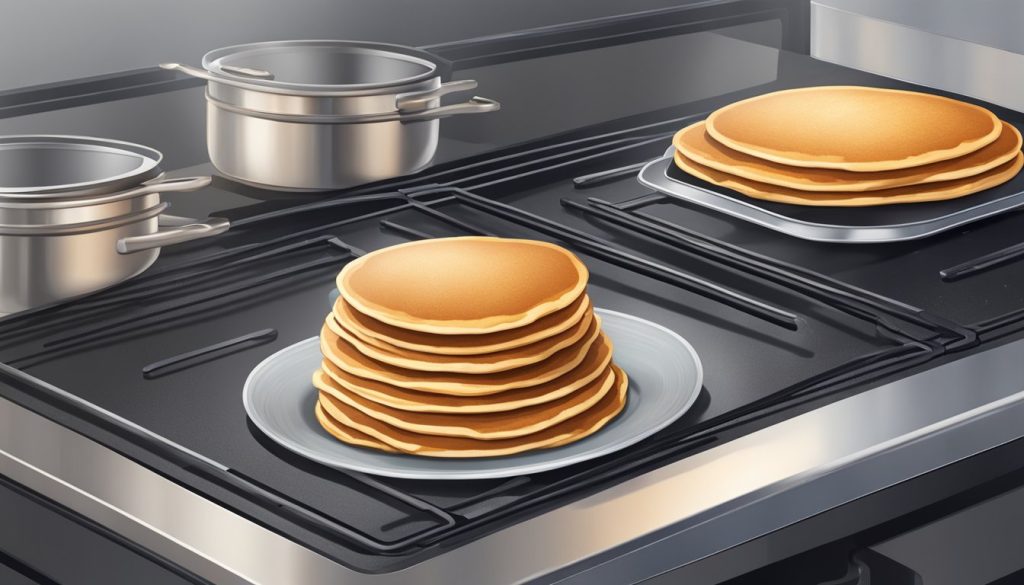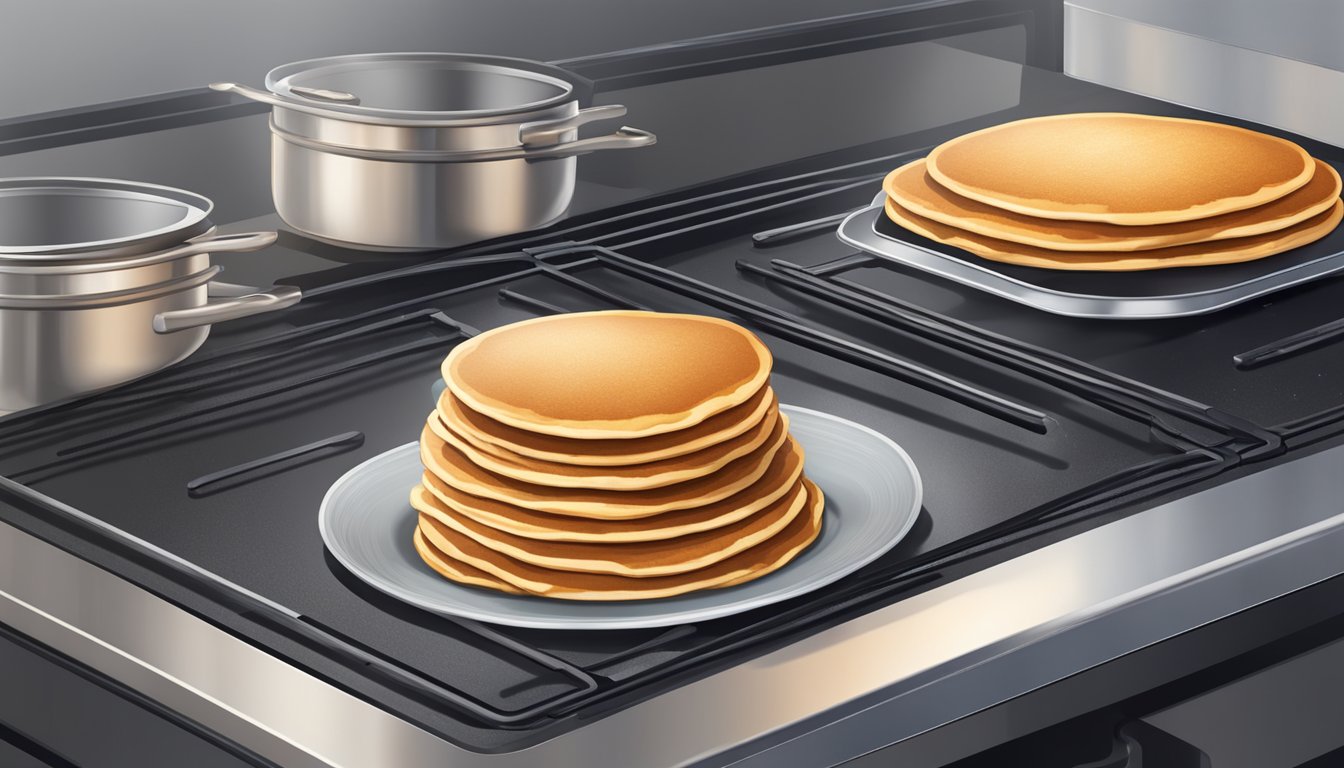Reheating buckwheat pancakes doesn’t have to be a challenge. With the right technique, you can enjoy these nutritious breakfast treats just as much as when they were freshly made. The air fryer stands out as one of the best methods to reheat buckwheat pancakes, delivering quick and crispy results in about 3 minutes at 350°F.

For those without an air fryer, several other effective options exist. The oven provides a reliable way to warm up a larger batch, while the microwave offers speed and convenience for individual servings. A skillet can also restore some of that fresh-off-the-griddle texture.
Whichever method you choose, properly reheated buckwheat pancakes can retain their unique nutty flavor and hearty texture. This makes them an excellent make-ahead option for busy mornings or a satisfying breakfast any time of day.
Benefits of Choosing Buckwheat Pancakes

Buckwheat pancakes offer unique advantages over traditional wheat-based varieties. They provide excellent nutritional value and distinct flavor profiles that set them apart from regular pancakes.
Nutritional Value of Buckwheat Flour
Buckwheat flour is a nutrient-dense ingredient that enhances the health benefits of pancakes. It is rich in protein, containing all nine essential amino acids. This makes buckwheat pancakes a complete protein source, ideal for vegetarians and vegans.
Buckwheat flour is high in fiber, promoting digestive health and helping to maintain stable blood sugar levels. It contains important minerals such as manganese, copper, and magnesium. These contribute to bone health, immune function, and energy production.
The flour is also a good source of antioxidants, particularly rutin. This compound supports heart health and may help reduce inflammation in the body. Buckwheat is naturally gluten-free, making it suitable for those with celiac disease or gluten sensitivity.
Differences Between Buckwheat and Regular Pancakes
Buckwheat pancakes have a distinct nutty flavor and darker color compared to regular pancakes. Their texture is often denser and more hearty, providing a satisfying eating experience. The unique taste profile pairs well with both sweet and savory toppings.
Regular pancakes are typically made with wheat flour, which contains gluten. Buckwheat pancakes offer a gluten-free alternative without sacrificing taste or texture. They tend to be more filling due to their higher fiber and protein content.
Buckwheat pancakes often have a lower glycemic index than regular pancakes. This means they cause a slower rise in blood sugar levels, potentially benefiting those managing diabetes or watching their carbohydrate intake. The robust flavor of buckwheat pancakes may reduce the need for excessive syrup or toppings.
Storing Leftover Pancakes

Proper storage is key to maintaining the taste and texture of leftover buckwheat pancakes. Refrigeration and freezing are both viable options, depending on how soon you plan to enjoy them.
Proper Storage for Freshness
Store leftover buckwheat pancakes in an airtight container or resealable plastic bag. Place a sheet of parchment paper between each pancake to prevent sticking. Refrigerated pancakes stay fresh for 2-3 days.
For best results, cool pancakes completely before storing. This prevents condensation and soggy textures. Label the container with the date to track freshness.
When ready to eat, remove pancakes from the refrigerator 15 minutes before reheating. This allows for more even warming.
Freezing Pancakes for Long-Term
Freezing extends the life of leftover buckwheat pancakes for up to 2 months. Lay pancakes in a single layer on a baking sheet and freeze for 1-2 hours. This prevents clumping.
Transfer frozen pancakes to a freezer-safe bag or container. Remove excess air to prevent freezer burn. Label with the date and contents.
To thaw, move pancakes to the refrigerator overnight. For quicker results, use the defrost setting on your microwave. Avoid thawing at room temperature to maintain food safety.
Reheating Pancakes in the Oven
Reheating pancakes in the oven is an effective method for restoring their warmth and texture. This approach works well for both small and large batches, ensuring even heating throughout.
Oven Method and Temperature Settings
Preheat the oven to 350°F (175°C) for optimal results. Place the pancakes on a baking sheet in a single layer, leaving space between each one to allow for even heating. For best results, cover the pancakes with aluminum foil. This helps retain moisture and prevents them from drying out.
Heat the pancakes for about 5-10 minutes, depending on their thickness and quantity. Check them periodically to avoid overcooking. For a slightly crispier exterior, remove the foil for the last 1-2 minutes of heating.
Preventing Dryness and Sogginess
To maintain the pancakes’ fluffy texture, avoid overheating them. Excessive heat can lead to dryness and toughness. If reheating frozen pancakes, thaw them in the refrigerator beforehand for more even warming.
For extra moisture, lightly brush the pancakes with melted butter before reheating. This adds flavor and helps prevent dryness. If the pancakes seem too dry after reheating, serve them with syrup or fruit compote to add moisture.
To prevent sogginess, avoid stacking hot pancakes immediately after reheating. Let them cool slightly on a wire rack before serving to allow excess steam to escape.
Reheating Pancakes on the Stove
The stovetop method offers precise control for reheating pancakes, allowing you to achieve crispy edges while maintaining a soft interior. This technique works well for both regular and buckwheat pancakes.
Skillet Technique for Crisp Edges
Heat a non-stick skillet over medium-low heat. Add a small pat of butter or a light brush of oil to prevent sticking. Place the pancakes in a single layer, leaving space between each one.
Cook for 2-3 minutes on the first side. Gently flip the pancakes using a spatula. Heat for an additional 1-2 minutes on the second side.
Look for slightly crispy edges and a warm, fluffy center. This method helps restore the original texture of freshly made pancakes.
Temperature Control and Timing
Maintain medium-low heat throughout the reheating process. Higher temperatures can burn the outside before the inside warms properly.
Monitor the pancakes closely to avoid overcooking. They should be heated through but not dried out. Cooking times may vary slightly depending on pancake thickness.
For buckwheat pancakes, which can be denser, allow an extra 30 seconds per side. Use a fork to test the center for warmth. Adjust heat or cooking time as needed for optimal results.
Using a Microwave to Reheat Pancakes

Microwaving is a quick and convenient method to reheat pancakes. This technique works well for both regular and buckwheat pancakes, preserving their texture and flavor when done correctly.
Microwave Method for Quick Reheat
Place 1-4 pancakes on a microwave-safe plate in a single layer. Cover them with a damp paper towel to retain moisture. Microwave on high for 15-20 seconds per pancake. For dense buckwheat pancakes, add 5-10 seconds to the heating time.
Check the pancakes after the initial heating. If they’re not warm enough, microwave in additional 10-second intervals. Avoid overheating, as this can make pancakes tough.
For even heating, arrange pancakes in a circle on the plate, leaving the center empty. This promotes uniform heat distribution.
Avoiding Rubberiness with Moisture Tricks
To prevent pancakes from becoming rubbery, use moisture-preserving techniques. Place a small microwave-safe cup of water next to the plate of pancakes. The steam created helps maintain softness.
Alternatively, sprinkle a few drops of water on each pancake before microwaving. This adds moisture directly to the pancakes, keeping them soft.
For buckwheat pancakes, which tend to be denser, consider using a lower power setting. Microwave at 50% power for a longer duration to heat them through without toughening the edges.
After reheating, let the pancakes rest for 30 seconds. This allows the heat to distribute evenly, resulting in a more consistent texture throughout.
Alternative Reheating Methods
Buckwheat pancakes can be revived using various techniques beyond traditional methods. These approaches offer unique textures and flavors while making the most of leftover pancakes.
Toaster for Crispier Edges
A toaster provides a quick and easy way to reheat buckwheat pancakes. Insert the pancakes into the toaster slots, ensuring they fit without bending. Use a medium setting to avoid burning.
The toaster method creates crispy edges while keeping the center warm and soft. This technique works best for thinner pancakes that can fit easily into standard toaster slots.
For added flavor, spread a thin layer of butter on the pancakes before toasting. This enhances the crispy texture and adds richness to the reheated breakfast treat.
Creative Ways to Re-serve Pancakes
Transform leftover buckwheat pancakes into new breakfast dishes. Cut pancakes into strips and bake them at 350°F for 10-15 minutes to create pancake “fries” – perfect for dipping in syrup or fruit compote.
Another option is to layer pancakes with fruit and yogurt to create a breakfast parfait. Alternate pancake pieces with Greek yogurt and fresh berries for a nutritious and visually appealing meal.
For a savory twist, use buckwheat pancakes as a base for breakfast sandwiches. Toast the pancakes lightly, then add scrambled eggs, cheese, and bacon or avocado slices between two pancakes.
Serving Reheated Pancakes
Reheated buckwheat pancakes can be transformed into a delightful meal with the right toppings and accompaniments. The nutty flavor of buckwheat pairs well with both sweet and savory options.
Best Toppings for Enhanced Flavor
Fresh fruit adds natural sweetness and a burst of flavor to reheated buckwheat pancakes. Sliced bananas, strawberries, or blueberries complement the earthy taste of buckwheat. For a classic touch, warm maple syrup drizzled over the pancakes creates a perfect balance of flavors.
Butter melted on top of the warm pancakes enhances their richness. A dollop of Greek yogurt or sour cream adds tangy creaminess. For those who prefer savory options, crumbled bacon or a fried egg on top turns the pancakes into a hearty breakfast.
Nut butters like almond or peanut butter spread on the pancakes provide protein and healthy fats. A sprinkle of cinnamon or a dusting of powdered sugar can add a touch of sweetness without overpowering the buckwheat flavor.
Pairings with Other Breakfast Foods
Reheated buckwheat pancakes pair well with various breakfast staples. A side of crispy bacon or sausage links adds a savory contrast to the pancakes. Fresh fruit salad provides a light, refreshing balance to the hearty pancakes.
Scrambled or poached eggs served alongside the pancakes create a protein-rich meal. A small serving of Greek yogurt with honey complements the pancakes’ flavors while adding probiotics to the breakfast.
For a beverage pairing, consider freshly brewed coffee, herbal tea, or freshly squeezed orange juice. These drinks cut through the richness of the pancakes and round out the meal.
A small portion of hash browns or roasted potatoes can add textural variety to the plate. For those with a sweet tooth, a scoop of vanilla ice cream turns the reheated pancakes into an indulgent dessert-like breakfast.
Special Considerations

Reheating buckwheat pancakes requires attention to their storage method and dietary restrictions. Proper techniques ensure optimal taste and texture while accommodating various needs.
Adjustments for Frozen vs. Refrigerated Pancakes
Frozen buckwheat pancakes need extra care when reheating. Thaw them in the refrigerator overnight for best results. This prevents uneven heating and soggy textures.
For refrigerated pancakes, reduce reheating time by 30-50% compared to frozen ones. They warm up faster and more evenly.
Use a lower temperature when reheating frozen pancakes to avoid burning the outside while the inside remains cold. Start at 300°F (150°C) and adjust as needed.
Separate frozen pancakes with parchment paper before reheating to prevent sticking. This step is less crucial for refrigerated ones.
Nut Allergies and Gluten Sensitivity
Buckwheat is naturally gluten-free, making it suitable for those with gluten sensitivity. However, cross-contamination can occur during processing or cooking.
Use separate utensils and cooking surfaces for buckwheat pancakes to avoid allergen contact. This is crucial for those with severe nut or gluten allergies.
Check labels carefully if using pre-made buckwheat pancake mixes. Some may contain added gluten or nut products.
For homemade pancakes, use certified gluten-free buckwheat flour to ensure safety. Avoid adding nuts or nut-based ingredients if allergies are a concern.
Clean all surfaces and equipment thoroughly before reheating to prevent cross-contamination.
